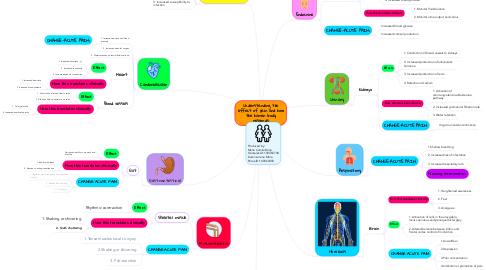
1. Cardiovascular
1.1. 1. Increase heart rate and blood pressure
1.1.1. CHANGE-ACUTE PAIN:
1.2. 2. Increased need for oxygen
1.3. 3. Water retention, potencial fluid overload
1.4. Heart
1.4.1. Effect
1.4.1.1. 1. Increased heart rate
1.4.1.2. 2. Increased contractility
1.4.1.3. 3. Increased speed of conduction
1.4.2. How this translates clinically
1.4.2.1. 1. Increased heart rate
1.4.2.2. 2. Increased blood pressure
1.5. Blood vessels
1.5.1. Effect
1.5.1.1. 1. Constriction of blood flow to skins
1.5.1.2. 2. Dilation of blood vessels to muscles
1.5.2. How this translates clinically
1.5.2.1. 1. Cold, pales skin
1.5.2.2. 2. Increased exercise capacity
2. Inmmune
2.1. CHANGE-ACUTE PAIN:
2.1.1. Nursing intervention
2.1.1.1. 1.Monitor temperature
2.1.1.2. 2. Use infection prevention and control measures
2.2. 1. Activation of HPA axis
2.3. 2. Increased or decreased sensitivity to pain
2.4. 3. Increased susceptibility to infection
3. Gastrointestinal
3.1. Gut
3.1.1. Effect
3.1.1.1. Decreased motility to stomach and intestine
3.1.2. How this translates clinically
3.1.2.1. 1. Inability to digest
3.1.2.2. 2. Nausea, vomiting, constipation
3.1.3. CHANGE-ACUTE PAIN:
3.1.3.1. 1. Reduced gastric emptying and intestinal motility
3.1.3.2. 2. Nausea and vomiting
3.1.3.3. 3. Constipation
4. Musculoskeletal
4.1. Skeletal muscle
4.1.1. Effect
4.1.1.1. Rhythmic contraction
4.1.2. How this translates clinically
4.1.2.1. 1. Shaking or shivering
4.1.2.2. 2. Teeth chattering
4.2. CHANGE-ACUTE PAIN:
4.2.1. 1.Tense muscles local to injury
4.2.2. 2.Shaking or shivering
4.2.3. 3. Pilo-erection
5. integumentary
5.1. Skin
5.1.1. How this translates clinically
5.1.1.1. 1.Pilo-erection (goose bumps)
5.1.1.2. 2. Hair standing on end
5.1.2. Effect
5.1.2.1. Constriction of blood flow to the skin
6. Produced by: María Camila Borja Gónzalez-ID:100060748 Karen Lorena Mora Pérez-ID:100060492
7. Respiratory
7.1. CHANGE-ACUTE PAIN:
7.1.1. 1.Shallow breathing
7.1.2. 2. Increased risk of infectation
7.1.3. 3. Increased respiratory rate
7.1.4. Nursing intervention
8. Endocrine
8.1. Liver/pancreas
8.1.1. Effect
8.1.1.1. 1. Breakdown of glycogen into glucose
8.1.1.2. 2. Increased metabolic rate
8.1.1.3. 3. Inhibition of insulin production
8.1.1.4. 4. Increased blood glucose
8.1.2. How this translates clinically
8.1.2.1. 1. Monitor fluid balance
8.1.2.2. 2. Monitor urine output and colour
8.2. CHANGE-ACUTE PAIN:
8.2.1. Increased blood glucose
8.2.2. Increased cortisol production
9. Urinary
9.1. Kidneys
9.1.1. Effects
9.1.1.1. 1. Constriction of blood vessels to kidneys
9.1.1.2. 2. Increased production of antidiuretic hormone
9.1.1.3. 3. Increased production of renin
9.1.1.4. 4. Retention of sodium
9.1.2. -How this translates clinically
9.1.2.1. 1. Activation of renin-angiotensin-aldosterone pathway
9.1.2.2. 2. Increased glomerular filtration rate
9.1.2.3. 3. Water retention
9.1.3. CHANGE-ACUTE PAIN:
9.1.3.1. Urge to urinate/incontinence
10. Nerveous
10.1. Brain
10.1.1. How this translates clinically
10.1.1.1. 1. Heightened awareness
10.1.1.2. 2. Fear
10.1.1.3. 3. Analgesia
10.1.2. Effect
10.1.2.1. 1. Activation of cells in the amygdala, locus coeruleus and periaqueductal grey
10.1.2.2. 2. Altered balance between limbic and frontal cortex control of micturition
10.1.3. CHANGE-ACUTE PAIN:
10.1.3.1. 1.Anxiet/fear
10.1.3.2. 2.Depression
10.1.3.3. 3.Poor concentration
10.1.3.4. 4.Inhibition or promotion of pain
